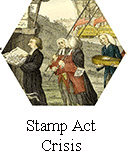 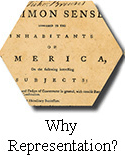 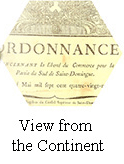 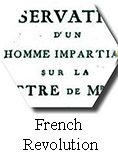 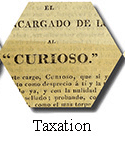 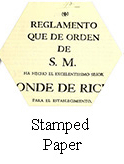 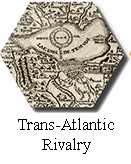 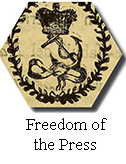 |
|
THE STAMP ACT CRISIS |
|
|
1. James Otis. The rights of the British colonies asserted and proved. Boston, New-England, printed: London reprinted, for J. Almon, [1764].
In his essay about the British pamphlet press, Adams states that the American pamphlet war in Britain began with the publication in December 1764 of this pamphlet by James Otis, which “masterfully summed up what was to become the American view of the constitutional position of the colonies within the British Empire.” The London reprint appeared just as Parliament was meeting to discuss, among other issues, the Stamp Act. |
|
|
2. Stephen Hopkins. The rights of colonies examined. Providence: printed by William Goddard, 1765. |
|
|
3. ---. The grievances of the American colonies candidly examined. London, 1765.
Stephen Hopkins was the governor of Rhode Island and a signer of the Declaration of Independence. This pamphlet, first published by the Rhode Island General Assembly, helped establish Hopkin’s reputation as a revolutionary leader and generated a long series of responses. The London edition, with a slightly modified title, includes John Carter Brown's descriptive notes. |
|
| |
RESPONSES TO THE STAMP ACT |
|
|
4. Vox Populi, Vox Dei A Providence Gazette Extraordinary. August 24, 1765. Providence, printed by S. and W. Goddard.
The verse around the edge reads: “Zuroyal Waterman is my name England is my nation Cranston is my dwelling place and Christ is my salvation”. |
|
|
5. A discourse addressed to the Sons of Liberty at a solemn assembly near Liberty Tree in Newport, February 14, 1766. Providence: Sarah and William Goddard, 1766.
The Stamp Act generated a vast amount of printed debate. These two items, produced by the press of William and Sarah Goddard in Providence, were held by the Waterman family of Cranston, Rhode Island. As the energetic annotations show, the children of the family—George, Phebe, and Zurial (or Zuroyal), used this pamphlet and “extra” to the Providence Gazette to rehearse both their handwriting and political sentiments.
On August 14, 1765, protesters in Boston hanged, beheaded, and burned in effigy the stamp tax collector Andrew Oliver, also destroying his home and warehouse. Two weeks later, a mob ransacked the house of Lieutenant-Governor Thomas Hutchison. The leaders of these and other acts of protest against the Stamp Act began issuing statements as the “Sons of Liberty”—sparking the formation of similar groups and tactics in other colonies. |
|
|
6. Polish artist and engraver Daniel Chodowiecki depicted the Boston Stamp Act protests in his series of twelve scenes from the American Revolution, issued separately in 1784 and as illustrations for Matthias Sprengel’s Allgemeines historisches Taschenbuch oder Abriss der merkwürdigsten neuen Welt-Begebenheiten enthaltend für 1784 die Geschichte der Revolution von NordAmerica . |
|
|
7. Nicholas Brown & Company to Captain George Hopkins (at Surinam), September 8, 1765.
On August 26, the scene was replayed in Newport, Rhode Island, as described in this letter from Nicholas Brown & Company to George Hopkins (brother of Stephen Hopkins), the captain of one of their vessels stationed in Surinam. The letter mentions the violence in Boston, and details the fate of the three appointed tax collectors of Newport, who were “obliged in the Most publick manner to Resighne”, their houses destroyed by a mob. The company also informs Hopkins about the formation of the Stamp Act Congress, set to meet in New York that October.
One of the tax collectors targeted by the protests in Newport was Martin Howard, a prominent lawyer and politician, who led a conservative defense of Britain’s colonial policies. His Letter from a gentleman at Halifax . . . appeared in January of 1765 as an attack on Hopkins’ The rights of the colonies—initiating a prolonged battle between Howard, Hopkins, and James Otis, waged on paper through a series of pamphlets and letters to the Providence Gazette. |
|
|
8. Martin Howard. A letter from a gentleman at Halifax to his friend in Rhode-Island: containing remarks upon a pamphlet, entitled, The rights of colonies examined. Newport, 1765. |
|
|
9. James Otis. A vindication of the British colonies: against the aspersions of the Halifax gentleman, in his Letter to a Rhode-Island friend. Boston, 1765. |
|
|
10. Martin Howard. A defence of the letter from a gentleman at Halifax to his friend in Rhode-Island. Newport, 1765. |
|
|
11. James Otis. Brief remarks on the defence of the Halifax libel. Boston, 1765. |
|
|
12. Ames’s almanack revived and improved: Or, An astronomical diary, for the year of our Lord Christ 1766.
A pirated edition of Ames’s Almanack, rushed into print before the application of the Stamp Act. The imprint line reads, “Price Before the Stamp Act takes Place Half-a-Dollar per Dozen, and 6 Coppers single. After the Act takes Place, more than double that Price.” |
|
|
13. THE REPEAL. or the Funeral Procession, of MISS AMERIC-STAMP. [London, 1766].
The economic effects of nonimportation protests and the unrest represented by the violent opposition to the Stamp Act contributed to the formal repeal of the act on March 18, 1766.
“Next appears the honourable Mr. Georg Stamp, full of Grief and dispair, carrying his favourite Childs Coffin, Miss Americ Stamp, who was born in 1765 and died hard in 1766.” The Stamp Act is to be interred in the “Family Vault,” which already holds the Star Chamber Court, Excise Money, and other governmental elements “which tended to alienate the Affections of Englishmen to their Country”. |
|
|
14. A collection of the most interesting tracts, lately published in England and America, on the subjects of taxing the American colonies, and regulating their trade. London: printed for J. Almon, 1766.
Bookseller John Almon printed many of the London editions of pamphlets concerning the issues between Britain and the American colonies. After the repeal of the Stamp Act in 1766, he bound the pamphlets on both sides of the controversy into this two-volume set. |
|
| |
This symbol indicates the entire scanned book,
may be read on the John Carter Brown Library's Internet Archive collection. >>> |
 |
| |
Exhibition prepared by dennis landis, kim nusco, neil safier, and kenneth c. ward.
on view in the reading room from october 2015 to january 2016. |
|